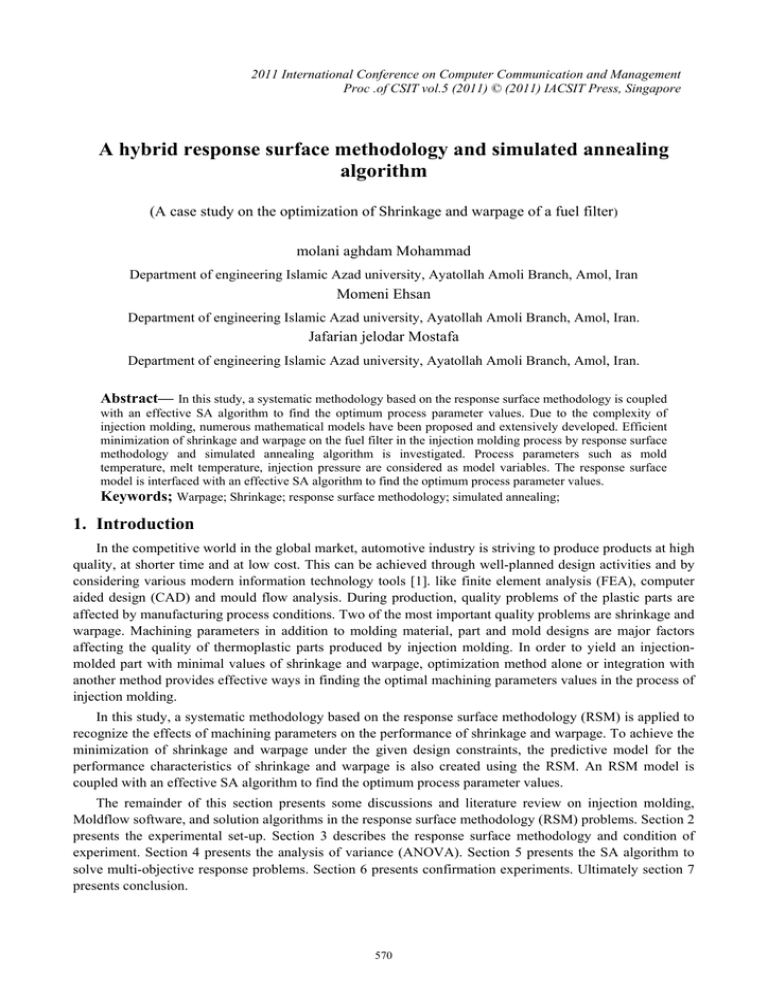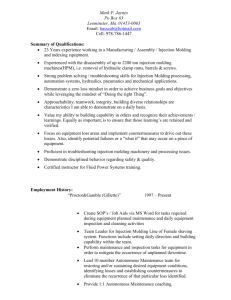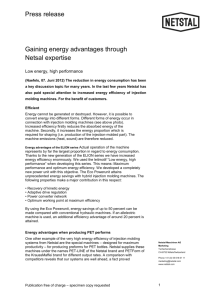Document 13134484
advertisement

2011 International Conference on Computer Communication and Management Proc .of CSIT vol.5 (2011) © (2011) IACSIT Press, Singapore A hybrid response surface methodology and simulated annealing algorithm (A case study on the optimization of Shrinkage and warpage of a fuel filter) molani aghdam Mohammad Department of engineering Islamic Azad university, Ayatollah Amoli Branch, Amol, Iran Momeni Ehsan Department of engineering Islamic Azad university, Ayatollah Amoli Branch, Amol, Iran. Jafarian jelodar Mostafa Department of engineering Islamic Azad university, Ayatollah Amoli Branch, Amol, Iran. Abstract— In this study, a systematic methodology based on the response surface methodology is coupled with an effective SA algorithm to find the optimum process parameter values. Due to the complexity of injection molding, numerous mathematical models have been proposed and extensively developed. Efficient minimization of shrinkage and warpage on the fuel filter in the injection molding process by response surface methodology and simulated annealing algorithm is investigated. Process parameters such as mold temperature, melt temperature, injection pressure are considered as model variables. The response surface model is interfaced with an effective SA algorithm to find the optimum process parameter values. Keywords; Warpage; Shrinkage; response surface methodology; simulated annealing; 1. Introduction In the competitive world in the global market, automotive industry is striving to produce products at high quality, at shorter time and at low cost. This can be achieved through well-planned design activities and by considering various modern information technology tools [1]. like finite element analysis (FEA), computer aided design (CAD) and mould flow analysis. During production, quality problems of the plastic parts are affected by manufacturing process conditions. Two of the most important quality problems are shrinkage and warpage. Machining parameters in addition to molding material, part and mold designs are major factors affecting the quality of thermoplastic parts produced by injection molding. In order to yield an injectionmolded part with minimal values of shrinkage and warpage, optimization method alone or integration with another method provides effective ways in finding the optimal machining parameters values in the process of injection molding. In this study, a systematic methodology based on the response surface methodology (RSM) is applied to recognize the effects of machining parameters on the performance of shrinkage and warpage. To achieve the minimization of shrinkage and warpage under the given design constraints, the predictive model for the performance characteristics of shrinkage and warpage is also created using the RSM. An RSM model is coupled with an effective SA algorithm to find the optimum process parameter values. The remainder of this section presents some discussions and literature review on injection molding, Moldflow software, and solution algorithms in the response surface methodology (RSM) problems. Section 2 presents the experimental set-up. Section 3 describes the response surface methodology and condition of experiment. Section 4 presents the analysis of variance (ANOVA). Section 5 presents the SA algorithm to solve multi-objective response problems. Section 6 presents confirmation experiments. Ultimately section 7 presents conclusion. 570 A. literature review on injection molding and design of experiment in injection molding Due to the complexity of injection molding, numerous mathematical models have been proposed and extensively developed by a growing numbers of studies for the analysis of different stages of the injection molding process[2]. The process of injection molding is an unstable cyclical work, which includes filling, packing, cooling, opening the mode cavity, injecting and closing the mode cavity. Warpage and shrinkage are among the most significant defects of the thermoplastic parts in terms of quality in the process of injection molding. The level of warpage and shrinkage is highly connected to the machining parameters of the injection molding operation. Numerous researches have been presented at scope of injection molding. Among which, we can consider the following studies: Jacques [3] examined thermal warpage in the injection-molded flat part of amorphous polymer due to unbalanced cooling during the process of injection molding. Huang and Tai [4] used the computer simulation and the experimental design of the Taguchi method to analyze the effective factors of warpage in an injection molded part with a thin-shell feature. Chen and Shiou [5] conducted to determine the optimal processing parameters in the finish operation of a free-form surface plastic injection molding, applying the Taguchi orthogonal array. B. backgrond of approaches to solve multi-response statistical optimization problems Until now many approaches have been proposed for the multiple-objective statistical problems. One of this methods introduced by Mollaghasemi et al. [6] that used a multi-attribute value function representing the decision-maker preferences. Then, they applied a gradient search technique to find the optimum value of the assessed function. A neuro-fuzzy and GA method was proposed by Cheng et al. [7] for optimizing the multiple response problems. Pasandideh and Akhavan Niaki [8] presented the genetic algorithm within desirability function framework for Multi-response simulation optimization. Periaux et al. [9] proposed a GA-based method that uses the concept of game theory to solve a bi-objective optimization problem. 2. Experimental set-up A. Obtained shrinkage and warpage In this study, the value of shrinkage is calculated by using the following formula: (1) Where is the long length of the cavity and is the long length of the fuel filter. The percentage of shrinkage being used in experiment is taken through the output of average linear shrinkage and amount of warpage is taken through the output of deflection all effects in MPI software. In the injection molding process, the lower both shrinkage and warpage are, the better the indication of the response characteristics. Those desired responses are regarded as the smaller-the-better characteristic and influence each other relatively. B. Material The material used in this experiment is a commercially available injection molding grade polyamide 66 (PA-66) for the product of the fuel filter. C. Mold parts and type of machine The electric horizontal-plastic-injection machine tool (250 ton) is used as the experimental machine in this study. The mold of the fuel filter is made of steel P-20. D. Machining parameter selection and experimental plan The factors of machining parameter and the factorial levels are recommended from the processing guides of PA-66 material and the correlated processing parameters of the mechanical equipment. There are three principal machining parameters specified, including the mold temperature (Mot), melt temperature (Met), injection pressure (Ip). In this study, these machining parameters are chosen as the independent input variables. TABLE I shows the levels of three machining parameters. 571 3. Response surface methodology RSM is an empirical modeling approach for determining the relationship between various processing parameters and responses with the various desired criteria and searches for the significance of these process parameters in the coupled responses. In this study, the experimental design adopts the centered central composite design (CCD) in order to fit the quadratic model of the RSM. The factorial portion of CCD is a full factorial design with all combinations of the factors at two levels (high, +1 and low, −1) and composed of the six star points, and one central point (coded level 0) which is the midpoint between the high and low levels. The star points are at the face of the cube portion on the design which corresponds to an α value of 1. This type of design is commonly called the face-centered CCD. A. Results and discussion The results of the machining performance evaluation of the fuel filter as per the experimental plan are tabulated in TABLE II. In order to ensure the goodness of fit of the quadratic model obtained in this study, we test for significance of the regression model. B. ANOVA analysis The resulting ANOVA table of the reduced quadratic model for the shrinkage and warpage are presented in TABLE III and IV. The reduced model results reveal that this model is still significant in the status of the value of “Prob. >F” is less than 0.05. In the same manner, The main effect of factor Me, Ip, Me2, Ip2 and MeIp are significant model terms. Through the backward elimination process, the final quadratic models of response equation in terms of coded factors are presented as follows: a). Shrinkage b). Warpage, Obtained models can be used to predict the values of shrinkage and warpage within the limits of the factors studied. 572 4. The simulated annealing algorithm to solve multi-objective problems In this section, we propose a simulated annealing algorithm to solve the multi-objective problem. Experiments show that this method has a high ability to find a solution in multi-objective problems. Firstly, it is necessary that we present some contents which are used in simulated annealing algorithm and concerned about multi-objective problems. In the following, components which are utilized in SA algorithm are presented. The most of components are come from the proposed algorithm of Pasandideh and Akhavan Niaki [8]. Desirability function One of the most widely used methods for considering the optimization of multiple-response problems is the desirability function approach. In order to describe the desirability function approach mathematically, suppose each of the (k=2) response variables are related to (p=3) independent variables by Eq. (2). (2) A desirability function, assigns numbers between 0 and 1 to the possible value of each response . The value of increases as the desirability of the corresponding response increases. We define the overall desirability, D, by the geometric mean of the individual desirability values shown in Eq. (3). (3) 573 Where in our problem. Note that if a response is completely undesirable, i.e., , then the overall desirability value is 0. Depending on whether a particular response is to be maximized, minimized, or assigned a target value, we can use different desirability functions. There are two types of transformation from to , namely one-sided and two-sided transformation. Since our problem is minimizing case, we should define one-sided desirability function displayed in figure 3 for this problem. In a one-sided transformation assume and be the lower and upper limits value of the response respectively such that . Afterwards, we define the desirability function as Eq. (4). (4) Where and are minimum and maximum value of the observation respectively. Values of and for shrinkage response variable are 3.573 and 3.757 respectively. Moreover, quantities of and for warpage response variable are 2.191 and 2.303 respectively. Mathematical model The mathematical model of the problem that we use its in the algorithm becomes: (5) ℎ=1, 2, 3 Where all the factors that construct the input of the problem are the independent variables . and are the lower and upper bounds of the independent variables. The output of the problem is the response variables denoted by . is the one-sided desirability functions for each response. 1 Figure 3. One-sided desirability function feasible solution In the SA algorithm, we define a set of the values for this problem. as a solution to the problem, where p=3 for Neighborhood In order to construct a neighborhood we replace an element of set defined as initial solution, with a randomly selected number within the boundaries of the parameter 错误!未找到引用源。[10]. Assume that selected elements are and , where j≠k. Then we change the values of and to the new values and according to Eq. 6, and 7, randomly and with the same probability: (6) (7) Where, is a uniform random variable between 0 and 1, and are the lower and upper limits of the specified element, is the number of current iteration, and is the maximum number of iterations. Note that the value of is transferred to its right or left randomly by Eq. 6, and 7, respectively and is this is an index with a value close to 1 in the first iteration and close to 0 in the percentage. Moreover, last generation that makes large production of Neighborhood in the early iterations and almost no production in the last iteration. 574 Objective function investigation After producing the new neighborhood by current solution, we need to investigate them. We generate the value of the response variables, desirability functions and total desirability, and compare these values with current solution's total desirability. Accepting the worse solution from current solution, we use a criterion called metro polis that its function is illustrated in Eq. 8. Where ∆E is the difference between the total desirability function of current solution and its neighborhood desirability. T(i) represent temperature in stage (i). Tuning parameters of the SA algorithm Decrease rate of temperature that we have used in SA showed in Eq. 9. (9) Where To and Tf demonstrate initial and final temperature that are tuned at 20 and 4 respectively, (i) represents stage, and N represents number of algorithm's stages. Implementation of the proposed method To solve the optimization problem, the SA algorithm has been written in MATLAB programming language. We consider tow responses (output variables: shrinkage and warpag) as polynomial functions of three independent variables (input variables: mold temperature, melt temperature, and injection pressure) as: Where the input variables ranging in , , , and are the error terms that their distributions are , and . After running the SA algorithm in the MATLAB software, we observe obtained values of input and output variables that are showed in TABLE V. Confirmation of experiments In order to verify the adequacy of the obtained quadratic model, the four confirmation experiments are performed for the shrinkage S and the warpage W. The data from the confirmation runs and their comparisons with the predicted values for the shrinkage S and the warpage W are listed in TABLE VI. From that, both the residual and percentage error are small. 5. Conclusions In this study, an efficient optimization methodology using response surface methodology (RSM) and simulated annealing algorithm (SA) is introduced in minimizing shrinkage and warpage of the fuel filter. Mathematical models of the shrinkage and warpage have been carried out to correlate the dominant machining parameters of the plastic injection molding process for simulating the fuel filter. To find the optimum value of machining parameters, the quadratic model of RSM is used. The results of ANOVA and conducting confirmation experiments show that the quadratic models of the shrinkage and warpage are fairly well fitted with the experimental values. The influences of all the machining parameters on the performances of shrinkage and warpage have been analyzed by the obtained mathematical models. The RSM model is interfaced with the SA algorithm to find the optimum process parameter values. 575 6. Acknowledgment This research has been partially supported by Islamic Azad University, Ayatollah Amoli Branch, Amol, Iran. These supports are gratefully acknowledging. 7. References [1] S.M. Sapuan, and H.S. Abdalla, 1998. A prototype knowledge-based system for the material selection of polymeric-based composites for automotive components, Composites Part A: Applied science Manufacturing, 29:731–742, [2] R.J. Crawford, 1989. Plastic engineering, 2nd edn. Pergamon, Oxford. [3] M. Jacques, 1982. An analysis of thermal warpage in injection molded parts due to unbalanced cooling, Polymer Engineering Science, 22:241–245. [4] M.C. Huang, and C.C. Tai, 2001. The effective factors in the warpage problem of an injection-molded part with a thin shell feature, Journal of Materil Processing Technology, 110:1–9. [5] F.J. Shiou, and C.H. Chen, 2003. Freeform surface finish of plastic injection mold by using ball-burnishing process, Journal of Materil Processing Technology, 140: 248–254. [6] M. Mollaghasemi, M.G. Evans, and W.E. Biles, 1991. An approach for optimizing multiple response simulation models, in the Proceedings of the 13th Annual Conference on Computers in Industrial Engineering, pp: 201–203. [7] B.C. Cheng, C.J. Cheng, and E.S. Lee, 2002. Neuro-fuzzy and genetic algorithm in multiple response optimization, Computers and Mathematics with Applications, 44:1503–1514. [8] S.H. Pasandideh, and S.T. Akhavan Niaki. 2006. Multi-response simulation optimization using genetic algorithm within desirability function framework, Applied Mathematics and Computation, 175: 366–382. [9] J. Periaux, M. Sefrioui, and B. Mantel, 1995, GA multiple objective optimization strategies for electromagnetic backscattering, in: D. Quagliarella, J. Periaux, C. Poloni, G. Winter (Eds.), “Genetic Algorithms and Evolution Strategies in Engineering and Computer Science; Recent Advances and Industrial Applications, ” John Wiley & Sons Ltd., Chichester, UK, pp: 225–243. [10] M. Gen, 1997. Genetic Algorithm and Engineering Design, John Wiley & Sons, New York, NY, USA. 576






